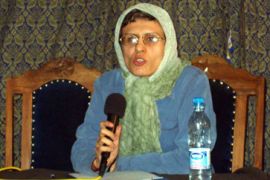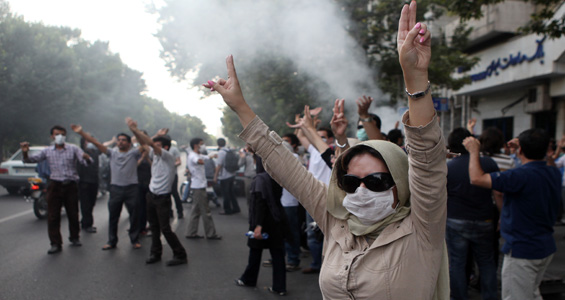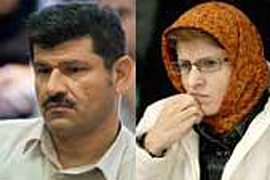For my friends in jail in Iran
Iranian author writes of the plight of journalists detained after the elections.

 |
| Several Iranian journalists were imprisoned for reporting on post-election demonstrations [GETTY] |
My friends and colleagues Jila Baniyaghoob and Bahman Ahmadi-Amouee have spent more than 45 days in Tehran’s Evin prison – without charge.
They are being held in Evin’s Ward 209, where ‘security’ or political prisoners are kept.
Keep reading
list of 4 itemsInside the pressures facing Quebec’s billion-dollar maple syrup industry
‘Accepted in both [worlds]’: Indonesia’s Chinese Muslims prepare for Eid
Photos: Mexico, US, Canada mesmerised by rare total solar eclipse
They are among some 30 Iranian journalists jailed following protests against the declared results of Iran’s presidential elections on June 12, whose names have been recorded by Reporters Without Borders and the Association of Iranian Journalists.
Last week, Jila’s mother and Bahman’s brother were allowed to see them, separately, for 10 minutes each at the prison. Jila’s mother, Eshrat Ouliayi, said Jila had lost weight and looked “emaciated”.
For those who have seen Jila before, thin and petite, this is very worrying.
Bahman is bigger.
But the court appearance by former president Mohammed Khatami’s deputy, Mohammad-Ali Abtahi, has shown what could happen to even larger people after such a long stay in prison.
Professionalism and compassion
 |
| Bahman and Jila were arrested shortly after the June 12 elections |
I first met Jila in 2004 in Kabul, the capital of Afghanistan.
She had been invited to speak at a conference organised by the Afghan Women Journalists’ Forum, with which I was working as a UN gender and media specialist.
She was impressive because of her courage and professional commitment and her personal passion for the people about whom she wrote, including the people of Afghanistan, as shown in this article, A Journey to Afghanistan.
I then met Jila in Tehran, along with her husband Bahman, another professional journalist. I have learned much from their reports and books.
Jila’s 2004 book, Rouznamehnegaran (Journalists), includes interviews with Iranian journalists who had lost their jobs as a result of widespread newspaper closures which began in 2000, one of whom had been jailed for drawing a cartoon.
The titles of Bahman’s two books, published in 2007, speak for themselves: The Political Economy of the Islamic Republic, and How the Islamic Republic’s Men Became Technocrats.
In May 2009, Jila won the Courage Awards, which are handed out by the International Women’s Media Foundation.
Jila and Bahman’s writings and my meetings with them gave me further evidence that Iranian journalists increasingly saw their work first and foremost as a means of keeping the citizens informed, rather than preaching or trying to indoctrinate them.
This did not mean that they had no views of their own, but that their professional work would consist of reporting accurate facts and informed comments, rather than their personal opinions.
‘Springs of freedom’
| Jila’s and Bahman’s blogs |
|
|
However, the ‘professionalisation’ of journalism could not be completed without the state also accepting journalists as independent professionals, rather than wanting them to be publicists for the government, or regarding them as ‘enemy mouthpieces’.
Khatami’s presidency in 1997 began a move toward recognising journalists as professionals, leading to a burst of excitement and creativity in the press, unprecedented since the early days of the 1979 revolution.
Both episodes were called ‘Spring of Freedom’. And both were brief, followed by repeated newspaper closures and imprisonment of journalists – some of whom left Iran so they could work freely.
For several of the journalists now in jail – including Jila and Bahman – prison is not a new experience. They have both been arrested before while covering protests demanding equal rights for women.
Both have written about their prison experiences. Bahman’s report has appeared in English on his blog under the title One week in Section 209 of Evin prison, the same ward where he and Jila are now kept.
This time, though, the detentions come at a time when the Iranian government faces widespread opposition, again unprecedented since the early days of the revolution.
Several prisoners are reported to have died as a result of torture, either in detention or soon after being released. As a result of the outcry over these deaths and the treatment of prisoners, one detention center at Kahrizak, near Tehran, has been closed down, having been declared ‘sub-standard’.
The televised ‘confessions’ of senior figures who have been loyal to the Islamic Republic, but critical of Mahmoud Ahmadinejad, the president, raise concern for the fate of journalists who have been reporting the protests as part of their professional work and may have also expressed their personal, critical views, in their blogs.
Free their voices
Last week, a large group of Iranian journalists wrote to Ayatollah Hashemi-Shahroudi, the head of the judiciary, asking for the unconditional release of the detained journalists.
One can only hope that this appeal and other appeals for the release of all those detained because of the recent protests are heeded by the Iranian authorities.
The detainees include some of Iran’s most creative minds, many of them young people. A country which takes pride above all in cultural achievements and whose young people make up the majority of its population needs to have such voices heard widely, rather than silenced.
As a friend, and a journalist, I wish to see Jila and Bahman and the other jailed journalists, safe, sound, and free, soon. As a human being, I wish the same for all the prisoners.
Hossein Shahidi teaches journalism at the Lebanese American University in Beirut. He is the author of Journalism in Iran (Routledge, 2007).
The views expressed in this article are the author’s own and do not necessarily reflect Al Jazeera’s editorial policy.
Al Jazeera is not responsible for the content of external websites.
